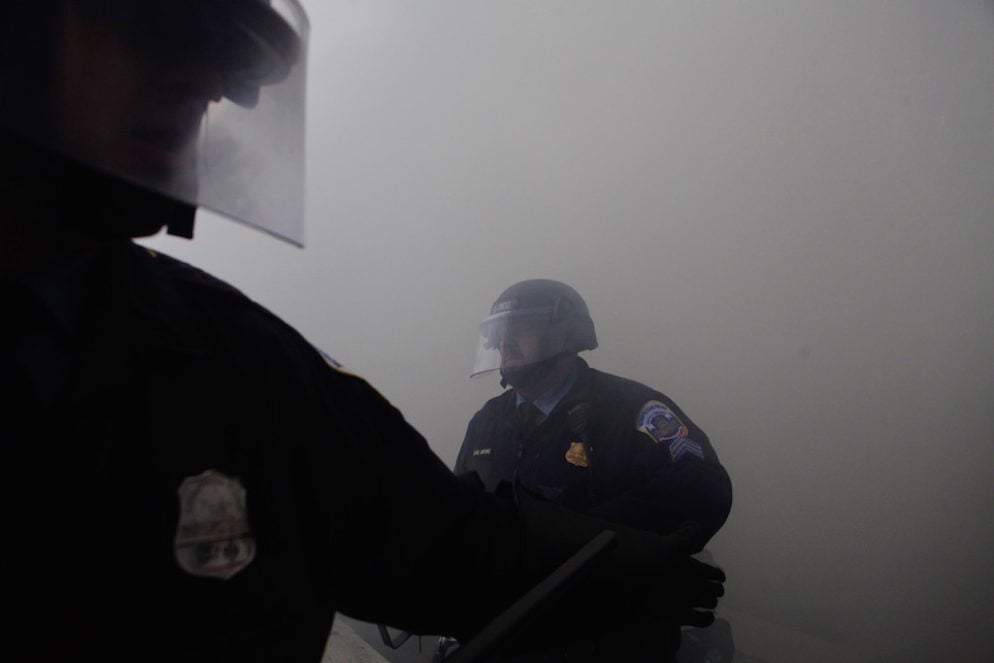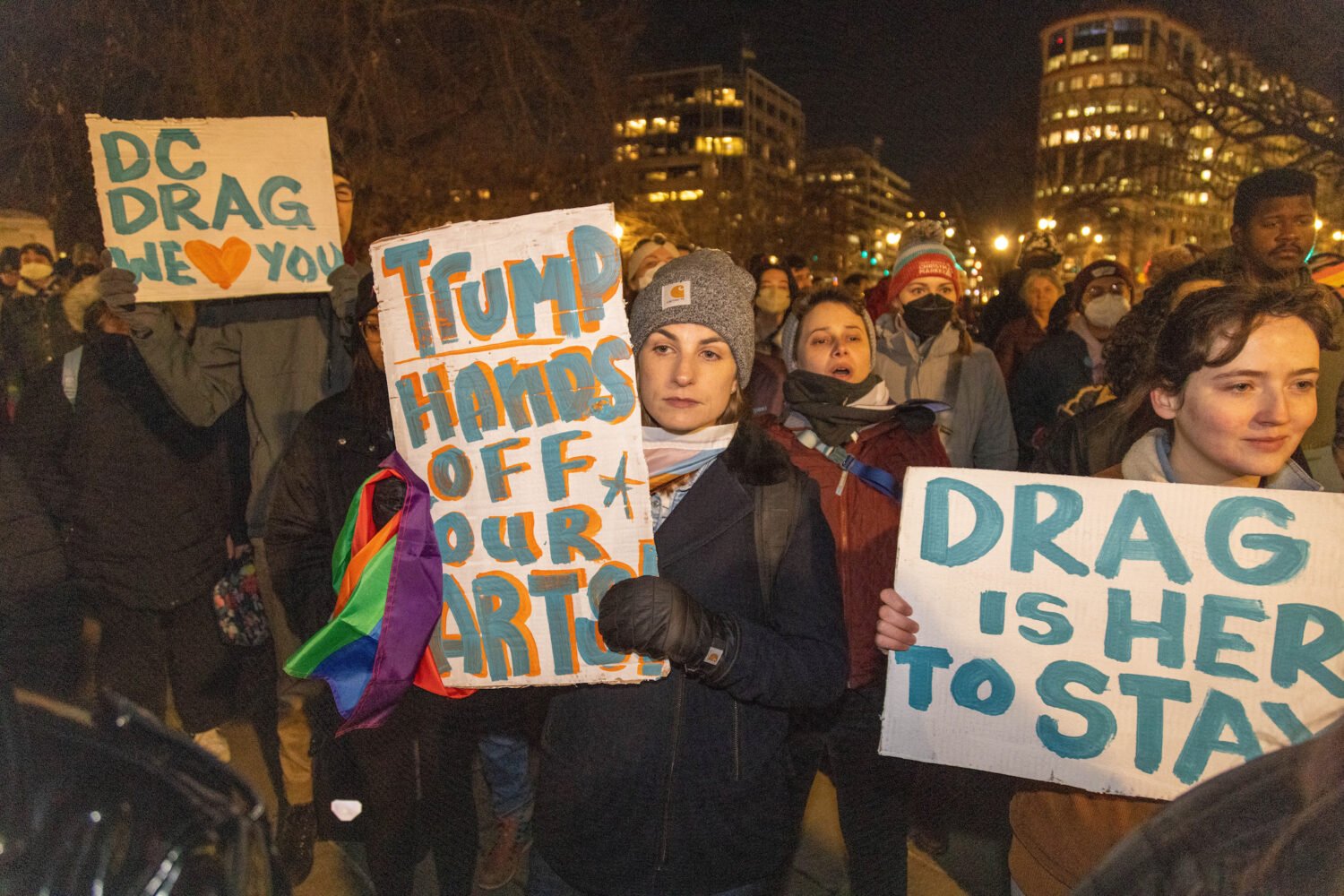Call it a tale of two livestreams.
On one hand, there’s Alexei Wood. He’s a photographer from San Antonio whose work depicts protests and weddings. He says he came to the District on Inauguration Day as a way to train for a future in combat reporting.
He livestreamed from an unpermitted demonstration that began in Logan Circle before heading towards Franklin Square around 10:20 AM. En route, some individuals in the 400-to-500-person crowd smashed windows, overturned newspaper boxes, and lit trash cans on fire in downtown DC.
The livestream shows that Wood was not among those engaging in property destruction, though he occasionally yells “Woo!” and provides commentary like “We’ve got some graffiti” as someone spray-paints “REVOLUTION OR DEATH” on a wall. Most of the people in the video are simply marching through the streets and chanting. Near the end of the 42-minute footage, Wood is among the more than 200 people surrounded by police in a tactic known as “kettling,” and reacts in pain to feeling the effects of tear gas.
Now, he’s in the first group of defendants facing trial for six felony charges—one count of inciting or urging to riot and five counts of destruction of property—and two misdemeanors that could result in more than 60 years in jail. A total of 187 people face those charges over the course of the next year, and seven more are looking at three misdemeanor charges for their alleged roles that day.
On the other hand, there’s Lauren Southern. She’s a controversial far-right blogger who gets upwards of 265,000 views on Youtube videos with titles like “Asking Feminists: Women’s Rights or Islam?” and tried to block refugee rescue missions in the Mediterranean over the summer.
Before that, though, she was in Washington, DC, on Inauguration Day, and she livestreamed from the incident in downtown DC that prosecutors call a “violent riot.” While Southern was initially trapped in the same kettle as Wood, police allowed her to leave prior to the mass arrests.
Part of her livestream was used as evidence in court on Monday, in the trial where Wood sits alongside co-defendants Jennifer Armento, Oliver Harris, Brittne Lawson, Michelle Macchio, and Christina Simmons.
Southern isn’t the only person police allowed to leave the kettle that morning. Keith DeVille, the commanding officer that day and the co-chairman of DC police department’s Presidential Inauguration Committee, testified in court on Monday that he directed a lieutenant to check claims from people purporting to be journalists and, “once verified, release them.”
“We knew we had some media folks in there—it was easily discernible that they were not part of the riotous group,” said DeVille, who added that officers largely determined who was a journalist based on media credentials (which he acknowledged had no centralized authorizing body) and whether they had big television cameras.
While DeVille said that “the majority of folks I saw documenting were on the periphery of the group,” he acknowledged after questions from Wood’s lawyer that, “If you’re trying to capture what’s going on in the group, yeah, you’ve got to be in the group.”
Not every reporter avoided arrest. A small handful of journalists were indicted with felony rioting the day after the Inauguration, though all but Wood and Aaron Cantú, now a writer for the Santa Fe Reporter, have seen their charges dropped. (Cantú’s trial is slated for next October.)
Wood declined to comment on Monday, though he told Washingtonian at jury selection that he was confident of his innocence. “If people want to critique my professionalism, I get it, but is it a criminal offense? Fuck no,” he said.
The prosecution has also entered footage from controversial far-right media figures. Macchio’s defense attorney, Jamie Heine, played a short clip from Southern’s livestream in court. He was asking DeVille for his observations about a person seen in a slew of footage from the day’s events. (Heine declined to comment about evidence.)
And last week, Assistant US Attorney Jennifer Kerkhoff showed a film recorded surreptitiously by Project Veritas at a planning meeting for Inauguration demonstration activities. Project Veritas is the James O’Keefe-led group that has been accused of deceptive editing practices in its sting projects. It most recently made headlines for a failed attempt to trick the Washington Post into publishing a false account of a sexual relationship with Roy Moore, the Republican candidate for senator in Alabama.
According to HuffPost, Kerkhoff tried to keep the name “Project Veritas” out of the court record, instead saying the footage came from a “third party provider.” Defense attorneys argued that the video shouldn’t be shown at all, because it was doctored, though ultimately, Judge Lynn Leibovitz allowed jurors to see it.
So far, jurors haven’t seen Wood’s livestream. Brett Cohen, his lawyer, declined to say if he planned on presenting it. Before the trial began, Leibovitz ruled that Kerkhoff could present statements from the footage as evidence, over objections from defense lawyers.
“It actually is not the same as Andrea Mitchell as I think about it because a newscaster would be neutrally pitching it,” Leibovitz said on November 14. “And here, what’s happening is, it’s a real time advertisement and recruitment measure, so that it’s a cheering of the event publicly to others. It’s a broadcasting to others as events are happening. It’s a celebration of particular events which are events that are– that constitute the violent and tumultuous conduct that makes up a riot, if true.“
As of the end of court Monday, federal prosecutors had not presented any evidence that the six defendants were responsible for the property destruction. Instead, they’re arguing that cheering for the destruction and otherwise being present on the scene are enough to constitute rioting.
That included testimony from arresting officers on the scene, who described some of the items the defendants had on them at the time of their arrest.
The video of Wood’s arrest, played in open court, included him reciting his Social Security number. His possessions collected for evidence included black clothing, goggles, a camera with a microphone attached, and a press pass with his photo and, for reasons yet to be explained, the name “John Osburn.” During his arrest, though, he gave his name as Alexei Wood. The arresting officer, Michael Molinari, described him as “cooperative” and said police never saw Wood with a weapon.
The journalists that police released from the kettle that day may have had backpacks filled with similar items. We’ll never know, though, because DeVille said that “they weren’t searched, their belongings weren’t searched.”
When Kerkhoff presented the items collected for evidence when Britnee Lawson was arrested, they did not indicate she was a journalist. Instead, she had what can only be described as a first aid kit—a utility belt with items like medical gloves, bandages, gauze, alcohol pads, and glucose tablets—along with a white helmet covered in red crosses, the international symbol of medical services.
Her lawyer, Sara Kropf, unpacked the objects one by one for the jury, calling them the “evidence of supposed crimes by Miss Lawson.”
The defendants’ alleged crimes weren’t the only ones being aired in court. Defense attorneys asked DeVille about the Office of Police Complaints report that outlined its monitors’ observations of officers’ indiscriminate use of nonlethal weapons like pepper spray without adequate warning, and the arrests of people who did not commit crimes. (The DC Council has granted the office’s request to fund a larger review.) They also entered into the record allegations from lawsuits alleging excessive force and unlawful arrests.
When asked by a defense lawyer, DeVille said that “criminal convictions would perhaps limit our civil liability in the matter.”



















